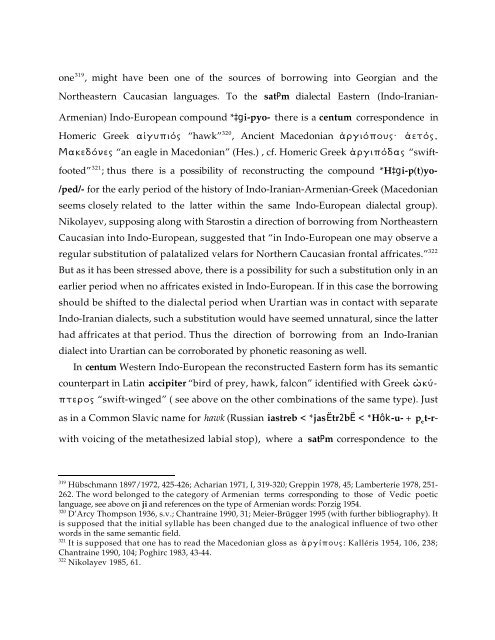Comparative Notes on Hurro-Urartian, Northern Caucasian
Comparative Notes on Hurro-Urartian, Northern Caucasian
Comparative Notes on Hurro-Urartian, Northern Caucasian
You also want an ePaper? Increase the reach of your titles
YUMPU automatically turns print PDFs into web optimized ePapers that Google loves.
<strong>on</strong>e 319 , might have been <strong>on</strong>e of the sources of borrowing into Georgian and the<br />
Northeastern <strong>Caucasian</strong> languages. To the satPm dialectal Eastern (Indo-Iranian-<br />
Armenian) Indo-European compound *‡´gi-pyo- there is a centum corresp<strong>on</strong>dence in<br />
Homeric Greek afigupiÒw “hawk” 320 , Ancient Maced<strong>on</strong>ian érgiÒpouw: éetÒw,<br />
MakedÒnew “an eagle in Maced<strong>on</strong>ian” (Hes.) , cf. Homeric Greek érgipÒdaw “swift-<br />
footed” 321 ; thus there is a possibility of rec<strong>on</strong>structing the compound *H‡´gi-p(t)yo-<br />
/ped/- for the early period of the history of Indo-Iranian-Armenian-Greek (Maced<strong>on</strong>ian<br />
seems closely related to the latter within the same Indo-European dialectal group).<br />
Nikolayev, supposing al<strong>on</strong>g with Starostin a directi<strong>on</strong> of borrowing from Northeastern<br />
<strong>Caucasian</strong> into Indo-European, suggested that “in Indo-European <strong>on</strong>e may observe a<br />
regular substituti<strong>on</strong> of palatalized velars for <strong>Northern</strong> <strong>Caucasian</strong> fr<strong>on</strong>tal affricates.” 322<br />
But as it has been stressed above, there is a possibility for such a substituti<strong>on</strong> <strong>on</strong>ly in an<br />
earlier period when no affricates existed in Indo-European. If in this case the borrowing<br />
should be shifted to the dialectal period when <strong>Urartian</strong> was in c<strong>on</strong>tact with separate<br />
Indo-Iranian dialects, such a substituti<strong>on</strong> would have seemed unnatural, since the latter<br />
had affricates at that period. Thus the directi<strong>on</strong> of borrowing from an Indo-Iranian<br />
dialect into <strong>Urartian</strong> can be corroborated by ph<strong>on</strong>etic reas<strong>on</strong>ing as well.<br />
In centum Western Indo-European the rec<strong>on</strong>structed Eastern form has its semantic<br />
counterpart in Latin accipiter “bird of prey, hawk, falc<strong>on</strong>” identified with Greek »kÊ-<br />
pterow “swift-winged” ( see above <strong>on</strong> the other combinati<strong>on</strong>s of the same type). Just<br />
as in a Comm<strong>on</strong> Slavic name for hawk (Russian iastreb < *jasËtr2bË < *Hô´k-u- + p e t-r-<br />
with voicing of the metathesized labial stop), where a satPm corresp<strong>on</strong>dence to the<br />
319 Hübschmann 1897/1972, 425-426; Acharian 1971, I, 319-320; Greppin 1978, 45; Lamberterie 1978, 251-<br />
262. The word bel<strong>on</strong>ged to the category of Armenian terms corresp<strong>on</strong>ding to those of Vedic poetic<br />
language, see above <strong>on</strong> ji and references <strong>on</strong> the type of Armenian words: Porzig 1954.<br />
320 D’Arcy Thomps<strong>on</strong> 1936, s.v.; Chantraine 1990, 31; Meier-Brügger 1995 (with further bibliography). It<br />
is supposed that the initial syllable has been changed due to the analogical influence of two other<br />
words in the same semantic field.<br />
321 It is supposed that <strong>on</strong>e has to read the Maced<strong>on</strong>ian gloss as érg¤pouw: Kalléris 1954, 106, 238;<br />
Chantraine 1990, 104; Poghirc 1983, 43-44.<br />
322 Nikolayev 1985, 61.





